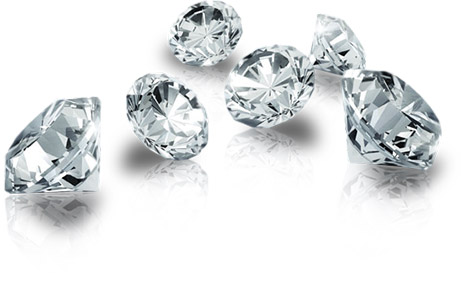WHAT ARE THE FOUR C'S OF A DIAMOND?

Not all diamonds are created equal. Every diamond has its own grade, comprised of the Four Cs.
- Cut
- Color
- Clarity
- Carat
The Four Cs of diamonds are the universal method for assessing the excellence of any diamond, anywhere in the world. Basically, the Four Cs of diamonds are how gemologists measure diamond quality and can help you choose the one that’s right for you.
DIAMOND CUT
The cut of a diamond has the biggest impact on a diamond’s overall appearance because it affects how well a diamond captures and reflects light back to the viewer’s eye. In other words, the cut makes a diamond sparkle. It is arguably the most important aspect to consider when diamond buying.
The cut grade depends on the quality of a diamond’s proportions and symmetry. When a rough diamond reaches the hands of a diamond cutter, they create the shape and cut of the diamond. A well-cut diamond will appear brilliant and sparkly, while a poorly cut diamond may appear dark and dull.
The pattern of cut surfaces — or facets — represents the quality of the cut and has a direct effect on the overall brilliance. With well-proportioned cuts, light reflects from one facet to another, then back through the top of the diamond

If the cut of a diamond is too deep, some light escapes through the side of the stone. If the cut is too shallow, light escapes through the bottom of the stone before it can be reflected, thus reducing its brilliance.
The cut grading system rates diamonds from Ideal to Poor. The Gemological Institute of America (GIA) currently only grades round-shaped diamonds as Ideal, but that doesn’t mean you can’t get a superior diamond in other shapes.
DIAMOND COLOR

“Diamond color” actually measures a lack of color. The less color in a diamond, the higher its value. The D-to-Z color-grading scale is the industry’s grading system for measuring color. The scale begins with the letter D, representing truly colorless and continues, with an increasing presence of color to the letter Z, which may signify a yellow or brown tint. We’ve created a diamond color chart (above) to illustrate the variations in the color you may find in your diamond buying journey.
While D, E, and F color grades are considered completely colorless, an untrained eye might not spot visible color in G, H, and I grades.
DIAMOND CLARITY
Clarity is the industry term to refer to each diamond’s microscopic “flaws,” or its imperfections. Because every diamond is hand-cut, each will have its own small imperfections. Inclusions, birthmarks, blemishes — the natural identity marks within each diamond — define its clarity. The fewer imperfections a diamond has, the more valuable it is. The more imperfections (or inclusions) a diamond has, the lower the clarity grade.
The GIA International Diamond Grading System™ has a scale to measure clarity grade, ranging from 0 (flawless) to 10 (included). Peruse this diamond clarity chart so that, when you’re shopping for a diamond, you can thoughtfully consider how visible imperfections will be to the naked eye.





FL, IF
These are flawless diamonds, no matter how closely you look. Flawless and internally flawless are the highest diamond quality clarity grades.
VVS1, VVS2
These diamonds have very slight inclusions, visible only under a microscope. These inclusions are difficult for even a trained gemologist to see.
VS1, VS2
These are very slightly included, difficult to see with the naked eye and somewhat difficult to see under a microscope.
SI1, SI2
These imperfections can be seen by the trained eye under 10x magnification. They might still be visible to the naked eye, but harder to see in diamonds smaller than 1ct.
I1, I2, I3
The lowest clarity grades. Inclusions are very easy for a trained eye to see under 10X magnification. These inclusions are often visible to the naked eye and in the case of I3 diamonds, the inclusions may affect the structural integrity of the diamond as well as impacting its brilliance.
CARAT WEIGHT
A diamond’s carat weight is the measure of its size. Depending on the diamond shape, weight distribution and cut quality, two diamonds with the exact same carat weight can be different sizes. Size is not everything — cut grade strongly affects the diamond quality and, ultimately, its beauty.
